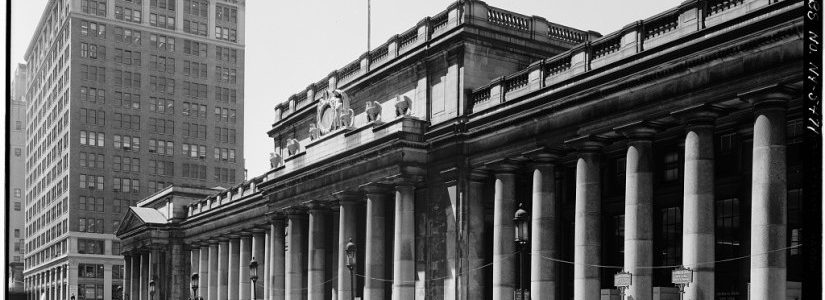
Sanford Malter
Sanford Malter describes how attitudes towards preservation shifted after the fight to save Pennsylvania Station.
In this brief interview, architect and preservationist Sanford “Sandy” Malter, a participant in the protest movement against the demolition of Pennsylvania Station, situates the demolition within the context of a broader debate among architects and architectural critics in the early 1960s over the direction of modernism and the value of preserving historic styles. Malter was interviewed by Annette Rosen in conjunction with NYPAP’s event, “Remembering Pennsylvania Station” 2003.
Q: Would you please tell us your name?
Malter: Yes. I’m Sanford Malter, known as Sandy, over the years. My connection to Penn [Pennsylvania] Station goes back to starting college at Cornell [University], and taking the night train to Ithaca, when they still had sleepers and steam trains. I would come into Penn Station on our holidays and several times a year, and did that for five years. In the early ’60s I worked at Lathrop Douglas Architects, where I worked closely with Elliot Willensky and Norval White. I was part of their influence, by then, to take action for the idea of saving Penn Station.
At the time there was a cultural war—which I think is still going on—where architecture had gone through stages of such gross simplification and elimination of detail that young architects were very conscious of the sterility of this. Penn Station became a focal point for the struggle between authenticity and richness and strictly speculative buildings. I remember a meeting at the AIA [American Institute of Architects] about that time, where the head of the AIA was confronted by a reporter from The New York Times. I think his name was Gilbert Millstein, who was very critical in front of the president of the AIA, of the status of architecture in the late ’50s and early ’60s, and used some really derogatory terms. Crawford—it was either Lawford or Crawford—who was president of the AIA, was very personally offended by Millstein’s criticisms, but I felt it was justified criticism of the practice of architecture in the late ’50s. I wrote a letter to Millstein telling him that I agreed with him and his comments against the AIA.
Since then, I still see that it’s an ongoing problem. I’m fortunate to be an architect specializing in preservation. I’ve had the pleasure of working on many fine Beaux Arts buildings and do my best to preserve them. Now there’s a motivation—at least in New York City—to maintain the value of buildings. There’s a value associated with Beaux Arts buildings in Manhattan, and that requires some skill, some intervention. That’s what I’ve been doing in the last twenty years.
Q: Do you think that the demolition of Pennsylvania Station had an effect on your career?
Malter: Definitely. It made me realize that we had to fight for architectural values. You could not take them for granted, and you needed to influence public opinion. In New York City, public opinion has turned around tremendously. Private citizens now spend money to preserve their buildings, tenant houses or co-ops. We do co-ops where they’re now stripping the paint from the stone, after dozens of years. It’s amazing that this has caught on, but I don’t know if it’s spread beyond the big cities. It’s an ongoing situation.
Q: However, when you say, the big cities—you feel that the demolition of Penn Station had an effect nationally, across the country?
Malter: Yes. Unfortunately, Chicago—another city I’m connected to, because of my wife’s family—had a very unsuccessful landmark law, and they’ve lost almost all the Louis Sullivan buildings. The Garrick Theater, the [Chicago] Stock Exchange—so other cities have not been successful. L.A. [Los Angeles] succeeded in saving the library. Nationwide, it isn’t a great picture. Philadelphia has succeeded a bit, and Boston. I’m not familiar with the southern cities—Memphis or some smaller cities, that have had some success. But the larger cities—St. Louis has lost the battle, probably, economically. They could maintain their downtown.
Q: Mr. Malter, I thank you very, very much for your remarks. They’re very valuable. Thank you for coming and speaking with us.
Malter: Thank you for inviting me.
[END OF INTERVIEW]